Gardner Report – Idaho Real Estate Market Update and Forecast
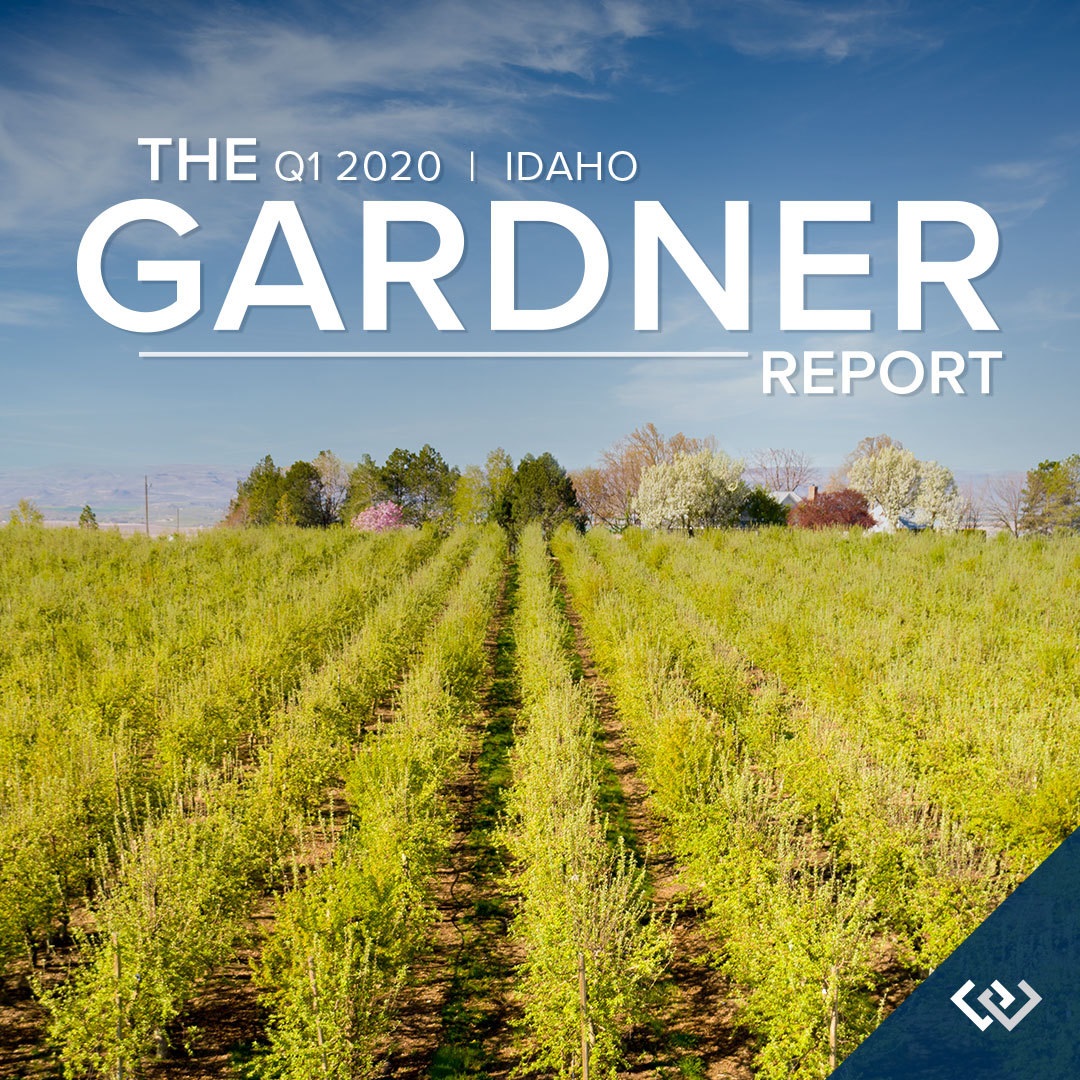
Posted in Idaho Real Estate Market Update by Matthew Gardner, Chief Economist, Windermere Real Estate
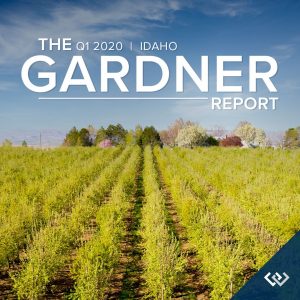 The following analysis of select counties of the Idaho real estate market is provided by Windermere Real Estate Chief Economist, Matthew Gardner. We hope that this information may assist you with making better-informed real estate decisions. For further information Idaho’s housing market, please contact us at 208-920-5966 or powerhouse@windermere.com
The following analysis of select counties of the Idaho real estate market is provided by Windermere Real Estate Chief Economist, Matthew Gardner. We hope that this information may assist you with making better-informed real estate decisions. For further information Idaho’s housing market, please contact us at 208-920-5966 or powerhouse@windermere.com
A MESSAGE FROM MATTHEW GARDNER
Needless to say, any discussion about the U.S. economy, state economy, or housing markets in the first quarter of this year is almost meaningless given events surrounding the COVID-19 virus.
Although you will see below data regarding housing activity in the region, many markets came close to halting transactions in March and many remain in some level of paralysis. As such, drawing conclusions from the data is almost a futile effort. I would say, though, it is my belief that the national and state housing markets were in good shape before the virus hit and will be in good shape again, once we come out on the other side. In a similar fashion, I anticipate the national and regional economies will start to thaw, and that many of the jobs lost will return with relative speed. Of course, all of these statements are wholly dependent on the country seeing a peak in new infections in the relatively near future. I stand by my contention that the housing market will survive the current economic crisis and it is likely we will resume a more normalized pattern of home sales in the second half of the year.
HOME SALES
- During the first quarter of 2020, 5,128 homes were sold, representing a solid increase of 12.6% compared to the first quarter of 2019 but down 9.9% compared to the fourth quarter of 2019. Read more.
- In Northern Idaho, Shoshone County experienced a significant increase in sales — up 15.5% over the first quarter of 2019. There was a modest increase in Kootenai Country and a very slight contraction in Bonner County. In Southern Idaho, sales rose by double digits in Valley, Canyon, and Ada counties. Blaine and Boise counties showed a modest decline in sales.
- Year-over-year sales growth was positive in two of three of the Northern Idaho counties, and sales rose in all but two Southern Idaho market areas over the same period a year ago.
- Pending sales rose in the quarter, suggesting that closed sales in the second quarter will be positive regardless of COVID-19.

HOME PRICES

- The average home price in the region rose 11.3% year-over-year to $382,601. Prices were 1.5% higher than in the fourth quarter of 2019.
- In Northern Idaho, Bonner County led the market with the strongest annual price growth, but there were solid gains in all counties. In Southern Idaho, Gem County saw prices rise a very significant 37.5%, and there were double-digit increases in all counties other than Valley.
- Prices rose in all Northern Idaho counties covered by this report compared to the first quarter of 2019, and rose in all but one Southern Idaho county.
- Inventory continues to be an issue, which is driving up home prices. Listing activity was down 7.2% compared to the first quarter of 2019. Listing activity was also down 8.8% compared to the final quarter of 2019.

DAYS ON MARKET
- It took an average of 112 days to sell a home in Northern Idaho, and 92 days in the southern part of the state covered by this report.
- In Northern Idaho, days on market dropped across the board. In Southern Idaho, market time dropped in Boise and Payette counties but rose in the other areas covered by this report.
- The average number of days it took to sell a home in the region dropped 2 days compared to the first quarter of 2019 but was up 21 days compared to the final quarter of 2019.
- Homes sold the fastest in Boise and Ada counties.

CONCLUSIONS

This speedometer reflects the state of the region’s real estate market using housing inventory, price gains, home sales, interest rates, and larger economic factors.
Given the current economic environment, I have decided to freeze the needle in place until we see
a restart in the economy. Once we have resumed “normal” economic activity, there will be a period of adjustment with regard to housing. Therefore, it is appropriate to wait until later in the year to offer my opinions about any quantitative impact the pandemic will have on the housing market.
ABOUT MATTHEW GARDNER

As Chief Economist for Windermere Real Estate, Matthew Gardner is responsible for analyzing and interpreting economic data and its impact on the real estate market on both a local and national level. Matthew has over 30 years of professional experience both in the U.S. and U.K.
In addition to his day-to-day responsibilities, Matthew sits on the Washington State Governors Council of Economic Advisors; chairs the Board of Trustees at the Washington Center for Real Estate Research at the University of Washington; and is an Advisory Board Member at the Runstad Center for Real Estate Studies at the University of Washington where he also lectures in real estate economics.
Economic & Housing Forecast presented by Matthew Gardner
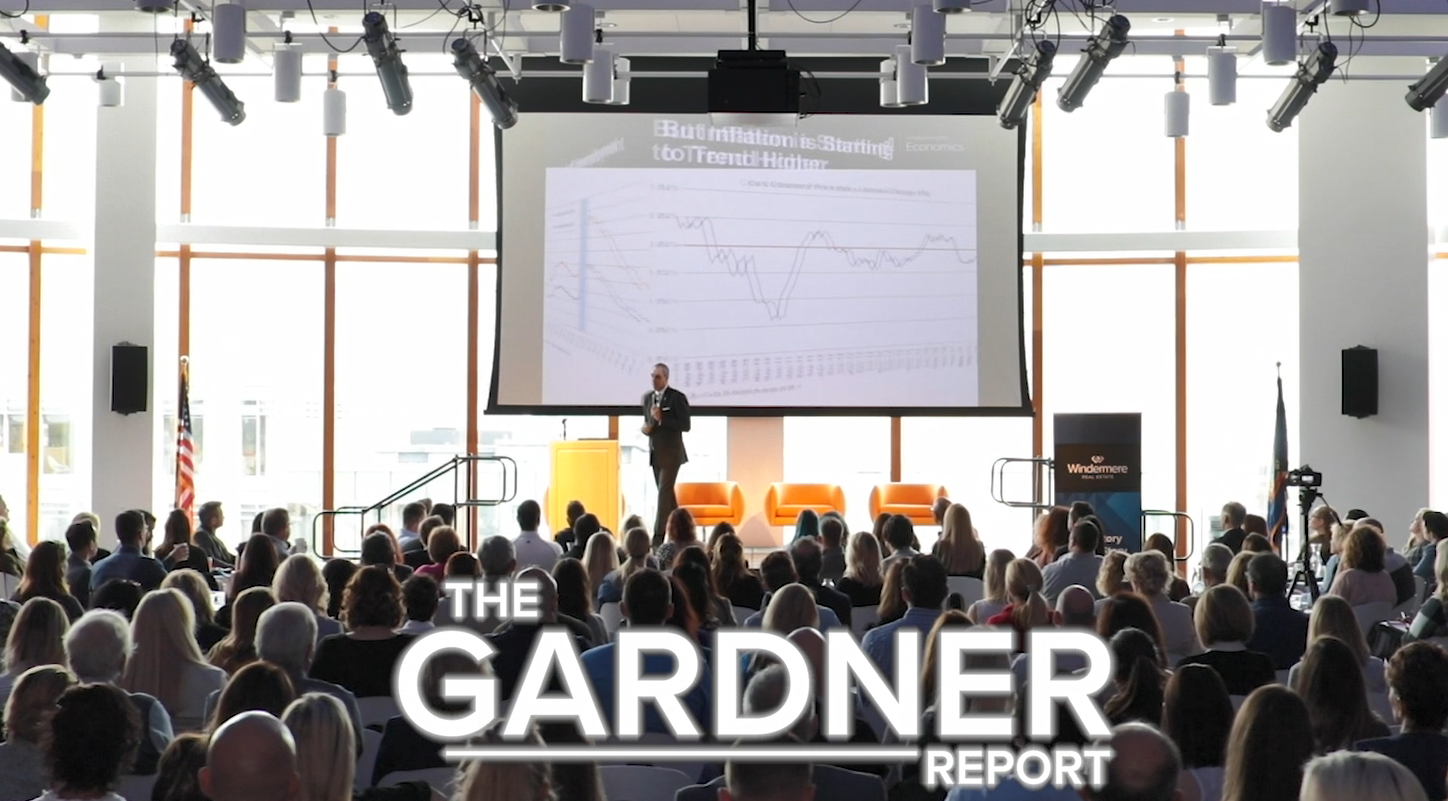
Save the Date
January 30, 2020 10 am- 12 pm
You are invited to join us as Matthew Gardner, Chief Economist for Windermere, presents a 2020 Economic and Housing Forecast for Idaho on January 30, 2020, 10 am – 12 pm at JUMP in Downtown Boise.
Matthew is responsible for analyzing and interpreting economic data and its impact on the real estate market on both a local and national level. regularly speaks at events around the country, is frequently quoted in the media in stories and publishes the Gardner Report, which highlights market conditions in regions throughout the Western U.S. View the 3rd Quarter 2019 Idaho Report here.
Please contact us if you are interested in attending or learning more about the upcoming event. PowerhouseGroup@Windermere.com or 208-920-5966.
Idaho 2019 3rd Quarter Real Estate Economic Report
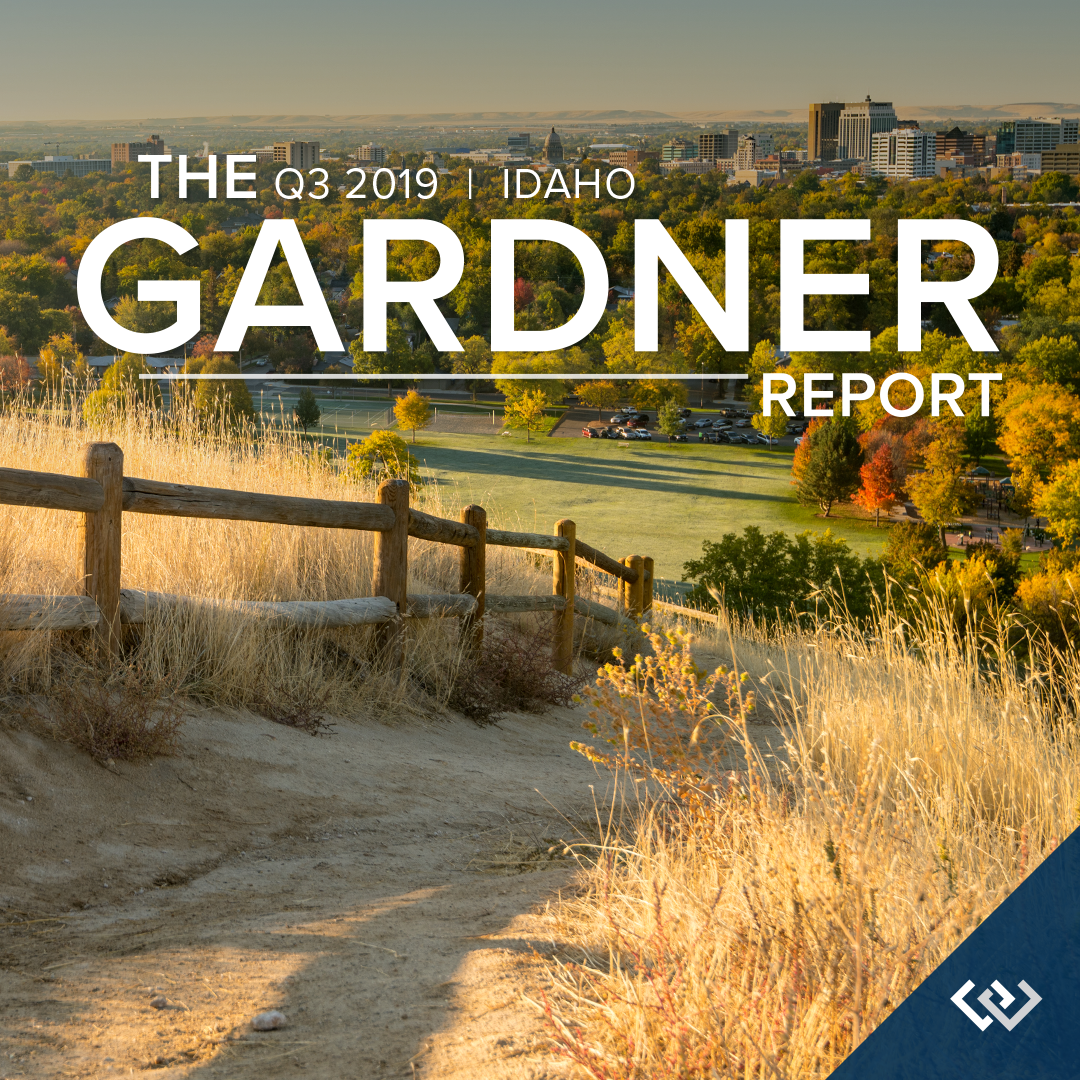
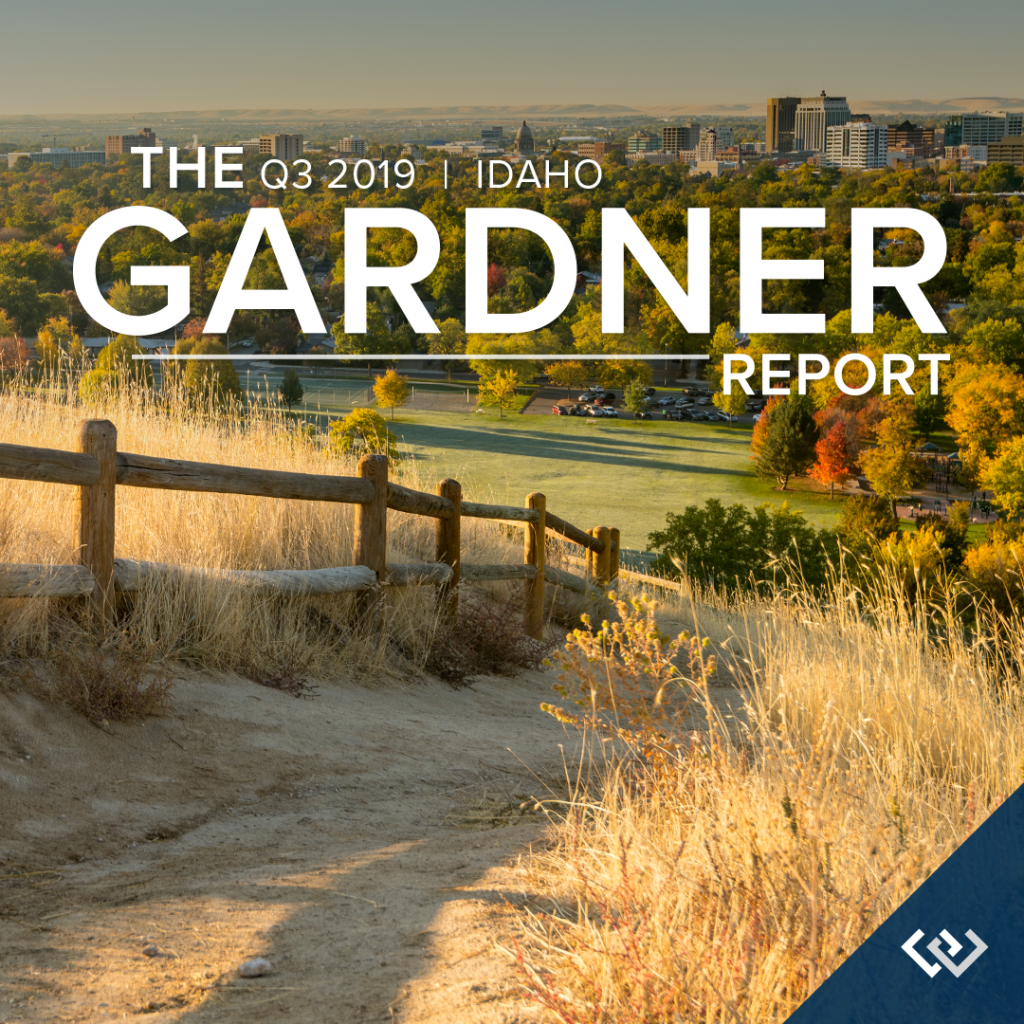 |
The following analysis of select counties of the Idaho real estate market is provided by Windermere Real Estate Chief Economist Matthew Gardner. We hope that this information may assist you with making better-informed real estate decisions. For further information about the housing market in your area, please don’t hesitate to contact us.
ECONOMIC OVERVIEW In August, the state unemployment rate was 2.9%, marginally higher than the 2.8% rate a year ago. It cannot be disputed that the state remains at full employment. It’s also interesting to note that the employment rate remained below 3% even as the labor force rose by 2.2%, suggesting that the economy remains very strong and new entrants to the labor force are finding jobs relatively easily. |
|
|
| HOME SALES | ANNUAL CHANGE IN HOME SALES Q3-2018 TO Q3-2019 |
| ❱ During the third quarter, 7,342 homes sold, representing a modest drop of 3.4% compared to the third quarter of 2018.
❱ In Northern Idaho, Shoshone County experienced a 17.9% increase in sales over the third quarter of 2018. There was a modest increase in Bonner County and a very slight contraction in Kootenai County. In Southern Idaho, sales jumped in Boise and Canyon counties. Blaine County also saw a slight increase, but sales activity was lower in the rest ❱ Year-over-year sales growth was positive in two Northern Idaho counties and three Southern Idaho counties. ❱ Pending sales rose in the third quarter, suggesting that closed sales in the final quarter of this year are likely to be an improvement over current figures. |
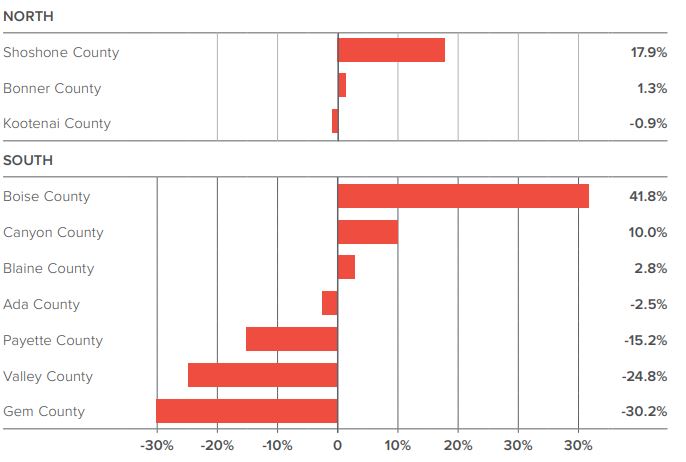 |
HOME PRICES
| ❱ The average home price in the region rose 8% year-over-year to $367,963. Prices were 2.7% higher than in the second quarter of this year. ❱ Prices rose in all counties compared to the third quarter of 2018. |
❱ In Northern Idaho, Shoshone County led the market with the strongest annual price growth. Bonner County also had solid price growth. In Southern Idaho, Gem County saw prices rise a very significant 29.7%, and there were notable increases in Valley, Canyon, and Boise counties. | ❱ Inventory continues to be an issue. The number of homes for sale is down 3.4% compared to the third quarter of 2018. Although listings are up 7% over the second quarter, the market remains very tight, and this is pushing prices higher. |
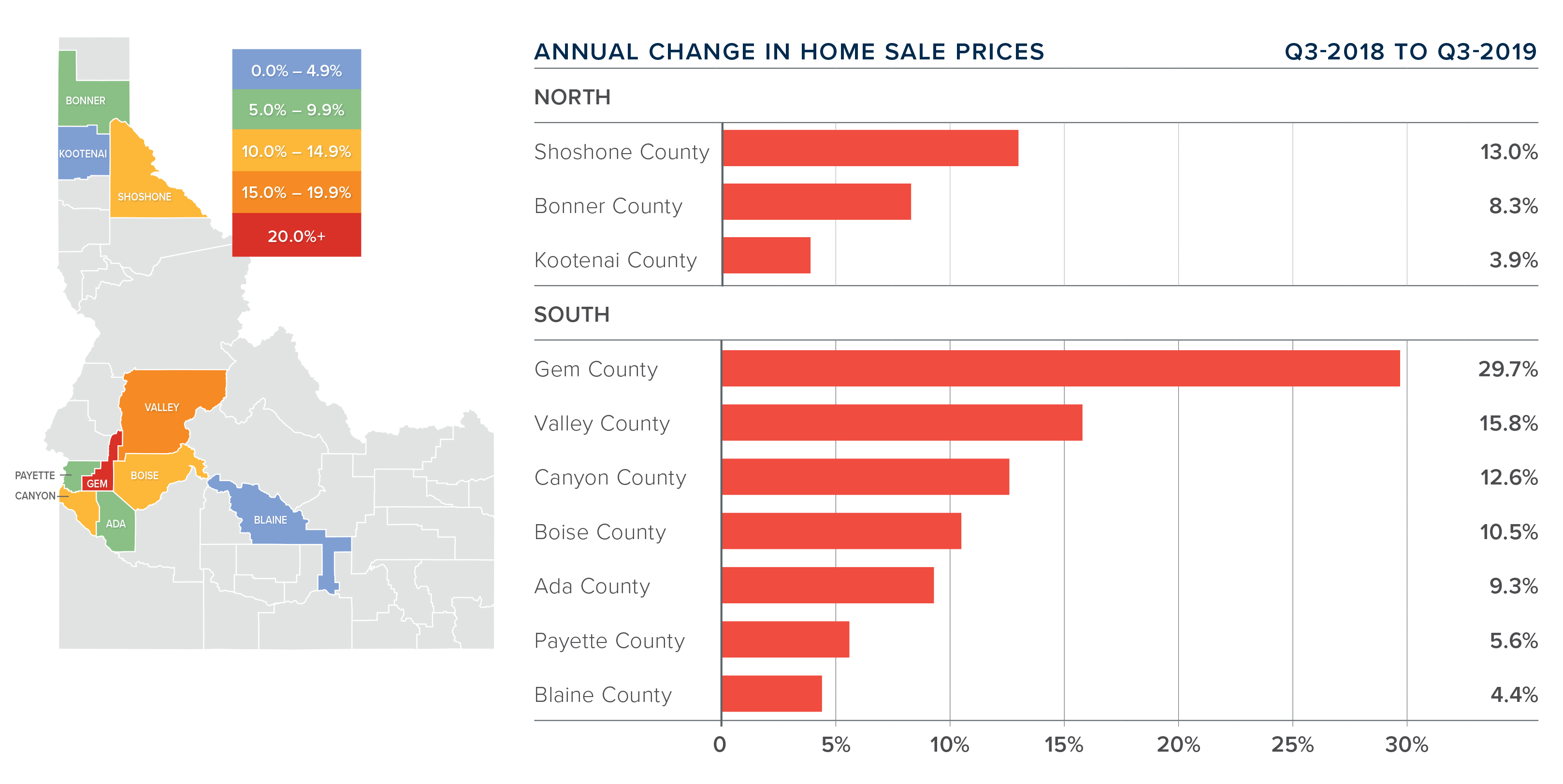
| ❱ It took an average of 94 days to sell a home in Northern Idaho, and 54 days in the southern part of the state.
❱ The average number of days it took to sell a home in the region dropped ten days compared to the third quarter of 2018. It was also ten days lower than in the second quarter of this year. |
❱ In Northern Idaho, days-on-market dropped across the board. In Southern Idaho, market time dropped in all counties except Ada and Canyon, though the rise in average market time was very modest.
❱ Homes sold the fastest in Gem, Canyon, and Ada counties. |
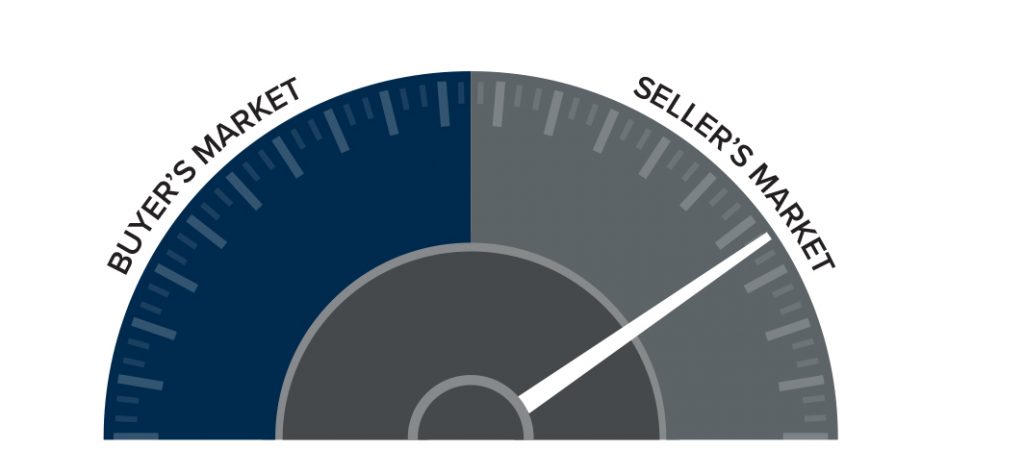 |
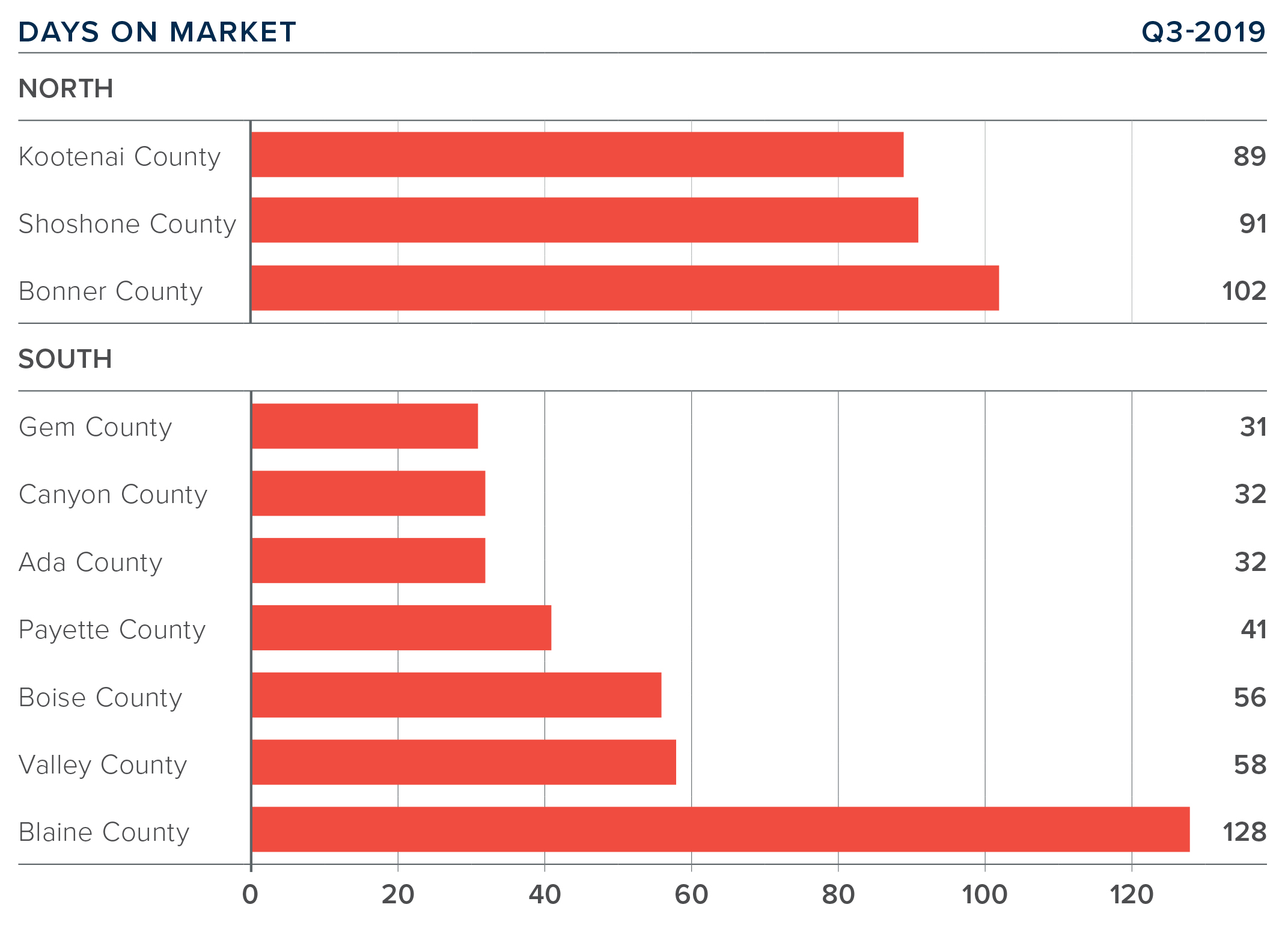 |
The speedometer reflects the state of the region’s housing market using housing inventory, price gains, home sales, interest rates, and larger economic factors.
Job growth continues to slow from the frenetic pace of the past few years but remains quite impressive. As is commonly known, economic/job growth leads to demand for homeownership and this continues to bode well for the Idaho market; however, home sales continue to be held back by a lack of inventory and this is leading to higher prices. As such, it remains a sellers’ market so I have moved the needle just a little more in their direction. ABOUT MATTHEW GARDNER Governors Council of Economic Advisors; chairs the Board of Trustees at the WA Center for Real Estate Research; and is an Advisory Board Member at the Runstad Center for Real Estate Studies at the University of Washington where he also lectures in real estate economics. |
|
Economic Update for Idaho Real Estate Market

The following analysis of select counties of the Idaho real estate market is provided by Windermere Real Estate Chief Economist Matthew Gardner. We hope that this information may assist you with making better-informed real estate decisions. For further information about the housing market in your area, please don’t hesitate to contact your Windermere agent.
ECONOMIC OVERVIEW
Job growth in Idaho continues to moderate. The state added 19,400 new jobs over the past 12 months, representing an annual growth rate of 2.7%. That said, the growth rate remains well above the national average of 1.7%. In March, Idaho’s unemployment rate was 2.9%, matching the level seen a year ago. The state remains at full employment, and it’s worth noting that the employment rate remained below 3% even as the labor force rose by 2%. This suggests the economy remains very strong as there are still job openings to accommodate new workers. Idaho continues to outperform the nation in terms of economic vitality and will continue to do so for the balance of the year.
HOME SALES
- 4,440 homes were sold during the first quarter of 2019, representing a drop of 4.3% compared to the first quarter of 2018.
- In Northern Idaho, Shoshone County was alone in experiencing sales growth, with an increase of 12% over the first quarter of 2018. There was a substantial drop of more than 15% in Bonner County, but this is a small area, making it prone to significant swings. In Southern Idaho, we saw modest sales growth in Payette County, modest declines in Canyon and Ada counties, and significantly lower sales in the small area of Boise County.
- Year-over-year sales growth was positive in just one Northern Idaho market, and only one of the Southern Idaho markets saw sales rise relative to the same period a year ago.
- When compared to the first quarter of 2018, the number of homes for sale was lower across the board in Northern Idaho and in most Southern Idaho market areas. It’s likely that this contributed to the decline in sales.
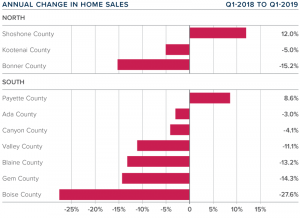
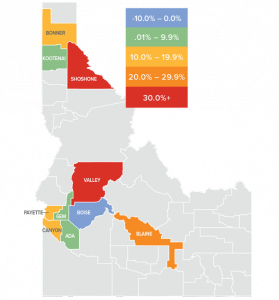
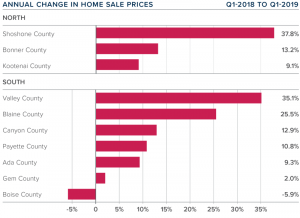

 Facebook
Facebook
 Twitter
Twitter
 Pinterest
Pinterest
 Copy Link
Copy Link